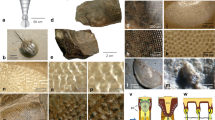Summary
The detailed structure of the ommatidium of the compound eye ofCaridina laevis shows that it has a tetragonal pattern of arrangement. Judged from the number of nuclei, distal retinal pigment cells are two, always placed against one angle of the cone. Around the rhabdome, seven proximal retinular cells, one rudimentary retinular cell and a tapetal cell, have been noticed. The relative position of the ommatidial pigments in the dark- and light-adapted eyes is shown.
The statocyst is of an extremely degenerate type, the homology of which is inferred from its relative position. The tactile hairs in the vicinity of the statocyst with the entangled debris might function as a static organ. The eyes also are shown to help the animal in orientation and equilibration.
Similar content being viewed by others
References
Bruin, G. H. P. and Crisp, D. J.J. expt. Biol., 1957,34, 447.
Debaisieux, P...La Cellule, 1944,50, 9.
*Delage, Y...Arch. Zool. exp. et Gen., 1887,5, 1.
Kleinholz, L. H...Biol. Bull. Woods Hole, 1936,70, 159.
Knowles, F. G. W... Ibid., 1950,98, 66.
Parker, G. H...Bull. Mus. comp. Zool., 1891,21, 45.
—————..Ergeb. Biol., 1932,9, 239.
Pillai, R. S...J. Mar. biol. Ass. India, 1960a,2, 57.
—————.. Ibid., 1960b,2, 226.
—————.. Ibid., 1961a,3, 137.
—————.. Ibid., 1961b,3, 146.
Polonovski, M., Bunsel, R. G. and Grundland, I.C.R. Acad. Sci. Paris, 1948,26, 2182.
Prentiss, C. W...Bull. Mus. comp. Zool., Harvard, 1901,36, 165.
Shen, C. J. ..Proc. zool. Soc. Lond., 1934, 533.
Welsh, J. H...J. exp. Zool., 1932,62, 173.
Author information
Authors and Affiliations
Additional information
Communicated by Dr. R. Subrahmanyan,f.a.sc.
Rights and permissions
About this article
Cite this article
Pillai, R.S. Studies on the shrimpCaridina laevis (Heller). Proc. Indian Acad. Sci. 58, 215–223 (1963). https://doi.org/10.1007/BF03051941
Received:
Issue Date:
DOI: https://doi.org/10.1007/BF03051941




